The region of Itanos is situated at the East Coast of Crete. It is based in Palekastro, a small town 19 km from Sitia. the overall area hosts important archaeological sites and spots of unique natural beauty marking this region as one of the last virgin destinations for holidays. At this district are also submitted the settlements Agathias, Vai, Mirtidia, Lidia, Chochlakies, the Toplos Monastery, the area of Itanos, Agios Nikolaos, Agios Spiridonas, Vagias, Kalamaki and Analoukas.
Itanos

A big and powerful ancient city in eastern Crete, 1 km away in the north
of Vai. It was established in the prehistoric period and probably named after
Phoenix or the Curette Itanos. Itanos was first found in Herodotus, described
as the home of the rock shells fisherman Corovius who led the Therans to Libya
where they founded Kyrini (631 B.C.) when Thera was suffering of drought.
Itanos was autonomous in the course of history and for great periods of time
was administrating Dragmos, Ampelos and Grammios, the Dionisades, Elasa and
Koufonisi (Lefki) islands and the temple of Dictean Zeus which was an important
revenue source. In the "Arbitration of the Magnet's" carried on
a plate in the wall of the main hall of the Toplos Monastery, the people from
Itanos were vindicated over the people of Ierapitna regarding the territorial
claim of Lefki.
 Itanos was a big harbour of cross-trade especially to the
East. It reached its peak in the classic period as one can assume from the
buildings, temples (of Asklepios, Tychi, Athena, etc.) and the silver coins
which are genuine pieces of art. The inscriptions found in Itanos are of great
significance.
Itanos was a big harbour of cross-trade especially to the
East. It reached its peak in the classic period as one can assume from the
buildings, temples (of Asklepios, Tychi, Athena, etc.) and the silver coins
which are genuine pieces of art. The inscriptions found in Itanos are of great
significance.
Especially in the Hellenistic time, Itanos was involved in conflicts with
the neighbouring cities of Praissos and lerapitna, but it managed to confront
them with the help of the Ptolemy's of Egypt without being politically dependent
on them. During the Roman time, Itanos kept its powerful position, contributed
to the Cretan public and issued its own coins.
 The city was flourishing towards
the first Byzantine period as the many big churches reveal and it is assumed
that it was inhabited in the time of the Venetian rule. Itanos was first traced
by the archaeologist Halbherr. Research was also conducted by Bursian and
Demarge, as well as by the French Archaeological School, while today the research
has been continued by the Institute of Mediterranean Studies. Many inscriptions,
coins, pots, golden earrings etc. were found. According to historical tradition,
the inhabitants of Itanos were driven away from the city in the 17th century
and founded Sitano.
The city was flourishing towards
the first Byzantine period as the many big churches reveal and it is assumed
that it was inhabited in the time of the Venetian rule. Itanos was first traced
by the archaeologist Halbherr. Research was also conducted by Bursian and
Demarge, as well as by the French Archaeological School, while today the research
has been continued by the Institute of Mediterranean Studies. Many inscriptions,
coins, pots, golden earrings etc. were found. According to historical tradition,
the inhabitants of Itanos were driven away from the city in the 17th century
and founded Sitano.
Nowadays, there are newly built summer houses within the archaeological site. Walking through Ancient Itanos through all these antiquities, the acropolis, the ruins of the Minoan buildings and temples, the inscriptions and bewitching environment is an unprecedented experience.
Palekastro
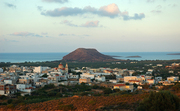
Palekastro is a lively, unpretentious village, at the east coast of Crete 20 km. away from Sitia and the seat of the region of Itanos. It was named after an old castle. Its sources main income is agriculture and tourism. Although the village is growing, it manages and retain its character and charm. The village square is the center of activities and is lined with cafes and taverns. Many a pleasant hour can be passed here, watching the world go by. During the summer months, weddings are often held in the village, with the huge wedding feast taking place in the square, to which everyone is invited. A chance to try your hand at Cretan dancing!
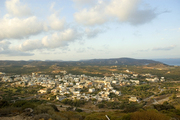
The town of Palekastro is an agricultural town which has opened its arms to embrace the mass tourism which has not quite arrived yet. There are plenty of working class taverns in the central part of town and plenty of working class people to fill them at night.
The town is slowly being built up as apartment buildings and hotels have sprung from the ruins of the traditional stone family dwellings which have been allowed to collapse in favour of commerce. An enjoyable 20 minute walk through olive groves leads to a number of beautiful, quiet beaches, one of which being at Kouremenos bay, famous for windsurfing. Europe's largest natural palm grove, bordering the beautiful beach of Vai is just 8km from Palekastro and is well-worth a visit. Set in a rocky landscape 10km from Palekastro, is the magnificent 14th century Toplou Monastery, which is open to visitors and has a rich collection of icons and other treasures, which can be viewed in the museum.

At the place Rousolakos on the Palekastro beach was revealed a big and significant Minoan town. It prospered at the Post-Minoan period but there was also found ruins from the first and the middle Minoan era especially graves perfectly maintained with numerous bones. The anthropologists after the examination of the bones came up with considerable conclusions about the body structure of the Minoans as i.e. that the men were 1.60 m. tall and the women 1.50 m. A central road crossing with four other roads divide the town in 9 districts in everyone of which according to a belief used to live equal genders. The fronts of the houses facing the central road are very imposing, while a complete sewage system runs all districts. At the district among other finds there is a department - mansion with 4 rows of columns and a kitchen, a bathing tank, well, a house altar, bathroom and an olive-oil storeroom while at other spots were found an olive-press and olives storeroom. There were also found many, amphoras, oil lamps, jar etc. Department mansions and important items were also found in other districts while in the district a grape-press was found. At the x district took place important discoveries: at the north-west under the house foundations was found the renowned temple of Dictean Zeus. At this temple Zeus was worshiped from the conquest.
Very near to that place were also found the plates with the hymn of the Dictean or Cretagenous Zeus. It is the first hymn in the ancient world dedicated to a god and in the reality it is about a hymn to peace and life. Young naked shield-bearers used to sing this hymn every year in the spring dancing around the Zeus altar imitating the Curettes and they pleaded him to come to earth in order to bring peace, happiness and justice among people, fertility to the ground, protection to the youth, fair winds to the ships etc. At this site were also found parts of the golden statuette, the so-called masterpiece of the Minoan culture, which is exhibited in the Archaeological Museum of Sitia.
The excavations were conducted about 100 years ago by the English archaeologists Bosanquet and Dawkins and are still ran by the English School of Archaeology. A recent investigation ("radiophotography") of the subsoil gave Serious evidence that under the ground of Rousolakos is hidden the fifth big Minoan palace from Crete!
Life in the Minoan town of Palekastro as in Zakros and in other Cretan towns was suddenly eradicated because of the volcanic eruption on Santorini in about 1500 BC. At Kouremenos were excavated 7 sub-Minoan houses, at Castri houses of the Geometric and the Hellenistic period while at the temple of Agios Antonios, Halbherr discovered a part of the treaty between Knossos and Ierapitnas.
Palekastro with the fertile grounds, important antiquities and marvelous beaches is the liveliest and a greatly developing settlement in the Sitia district. In the town there is a folk museum and many cultural events are taking place.
Nowhere else in the world the Nature and the Myth match so well together.
It is remarkable that the habits and rituals worship, the myths and the Legends
survive even today in some villages of Sitia!!
Elia
Ancient city built in today's position of Rouso - Lakos was called ELIA (1690
B.C.). Well designed functional Minoan structures of the after - Minoan era.
Skeleton traces of early and mid - Minoan era gives the feeling to today's
visitor of an untouched Minoan city with broad roads and large building blocks.
It is considered the second in size ancient Cretan City after Knossos. Excavations
carried out even today by British Archaeologists, revealed important findings
as the sacred temple (Dikteou - Dia) at the tip of mount Petsofa, (steep mountain
in the south of Rouso - Lakos). Many of the important archaeological findings
are on display at the museum of Sitia, Iraklion and at many foreign museums.
Lately an important archaeological discovery was a statuette 50 cm tall made
of gold and ivory that constitutes a magnificent piece of Minoan Art is said
to represent a Minoan young god and can be viewed at the Museum of Sitia.
Vai
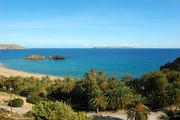
A palm tree forest stretching on a marvelous valley and sandy beach, next
to the ancient Itanos, 28 km away from Sitia. It is 8 km away from Palekastro
and 6 km. away from Toplou Monastery. It covers 200 acres and consists of
self planted palm trees of Theophrastus (Phoenix Theofrasti). It is unique
of its kind in Greece, Europe and probably the world. Apart from Vai, individual
palm trees or clumps of them are to be found in other parts of Crete as well
(Preveli, Agios Nikitas etc.), on the islands in the southeast of the Aegean
Sea, in Cyprus and Turkey. There are many legends about how it was created.
It is said that it was created by the Phoenicians who as it was believed were
the first to settle Itanos, while according to other versions it was created
by the seeds of dates that Egyptian soldiers of Ptolemy VI (pilometor) used
to eat, or the soldiers of King Mithridates of Pontus who came as allies to
that area, or Saracen pirates or invaders.
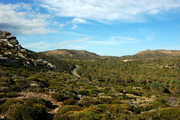 Whatever may be the cause of the
Vai forest's existence, one thing is for sure, it is maintained due to the
dry, hot climate and the underground water of the valley. In addition, the
palm tree existed in ancient Crete as mentioned in the works of Theophrastus
and Pliny and the depiction of the palm tree on coins and pots. There are
clumps of palm trees also on the beach of the neighboring Itanos. Apart from
palm trees, you also find other species of African vegetation that contribute
to the biodiversity of this area. This location is also the meeting point,
the crossroad for migrating birds.
Whatever may be the cause of the
Vai forest's existence, one thing is for sure, it is maintained due to the
dry, hot climate and the underground water of the valley. In addition, the
palm tree existed in ancient Crete as mentioned in the works of Theophrastus
and Pliny and the depiction of the palm tree on coins and pots. There are
clumps of palm trees also on the beach of the neighboring Itanos. Apart from
palm trees, you also find other species of African vegetation that contribute
to the biodiversity of this area. This location is also the meeting point,
the crossroad for migrating birds.
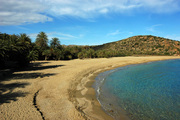
The landscape is one of the most beautiful ones: soft lines in the horizon, harmonious diversity of hills and plains, olive groves and vineyards on the hillsides, an exotic African flair and bright light. While the ancient sites at the Toplou Monastery give historic and cultural significance to the area.
Vai because of its special value and beauty is protected by the Greek state, European Union and international contracts.
Zakros (Epano)
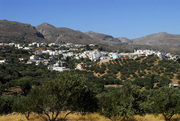
It is a village within a green environment in the eastern edge of Crete, 38 km away from Sitia. The following settlements belong to the administrative district of Pano Zakros: Kato Zakros, Adravasti, Azokeramos, Kellaria, Klisidi and the monastery dependencies: Agios Georgios, Sfaka, Kaneva, and Skalia. Archaeological sites have been traced in many of this area as well as a temple on the peak of Traostalos.
On the road to Kato Zakros at the village limits, the archaeologist professor N. Platon
excavated a Minoan mansion with a stone winepress and murals with plant topics of various colours and a large jar with characters of the linear. At the upper part of the village, are the big and renowned springs of Zakros and in the village there are many water mills which were recently restored for the foundation of the Water Museum.
Zakros (Kato)

It is a coastal area with a settlement 8 km away from Pano Zakros at a magnificent bay with sandy beach. Kato Zakros is a most impressive small fishing village, hidden away in the south-east corner of Crete, behind a beautiful tamarisk-fringed beach. There are several excellent fish taverns on the beach, ideal for relaxing, long lunches or for romantic evening meals. Although the palace attracts many visitors during the day, by evening due to a very limited supply of accommodation, Kato Zakros is quiet again and as such is ideal for the visitor who wants to get away from it all. Anyone staying in Kato Zakros will want to walk down the "Valley of the Dead", approximately a 2-hour walk, which leads down from Pano, to the sea at Kato Zakros.
Here, in 1961 the renowned archaeologist Nikolaos Platon traced and excavated the fourth Minoan Palace on Crete. The first to trace evidence of ancient ruins was Spratt. After him the archaeologists' Halbherr and Mariani, Evans and Hogarth searched the area, while golden jewels found by a peasant and the finds handed in by Em. Figetakis and N. Karantonis gave evidence of the existence of ancient sites. The first excavations of N. Platon were financed by the American art-Lovers Leon and Harriet Pomerance. The overall size of the central building was bigger than 10 acres and there were about 250 chambers for different use. The palace was not looted when found so although smaller than the ones in Knossos, Festos and Mallia, the finds there were more in number (over a 1000) and more significant, thus giving us valuable information about the life and civilization of the Minoans. Many of them are "royal", real pieces of art.
The palace was mostly developed due to its geographic position. It was the big port of call for the Minoan ships coming from and heading to Egypt and the East. This was evidenced by the many finds and raw materials coming from these areas. The handicraft and arts were particularly developed in the Palace of Zakros and were very profitable. The palace finds are exhibited in the Museums of Heraklion, Sitia and Agios Nikolaos. The palace was unexpectedly destroyed by the volcanic eruption in about 1500 B.C. It is an extraordinary experience to visit the palace.
The Greek Fund of the Archaeological Resources and Expropriations (TAPA)
has published a brief guide where you can find basic information. Moreover
interesting excavations have taken place in the palace annexes. The old palace
was located there, a metal furnace was found and other buildings were revealed
with numerous finds, plates etc. In the gorge of Zakros (that is why it was
named the gorge of the dead) and on the hill of Agios Antonios tombs in caves
were excavated. The porous stone quarry with which the palace at Pelekita
was built was found there as well as a cave with traces of Neolithic habitation.
Kato Zakros is an archaeological paradise in a pure natural landscape of exceptional
beauty.



